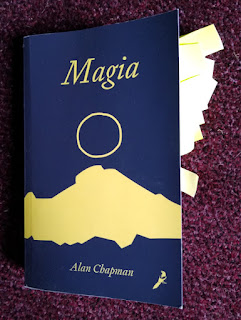‘Looks like a felony’ - a review of Blotter: the untold story of an acid medium
Blotter: the untold story of an acid medium by Erik Davis
The book consists of a lengthy essay by Erik Davis on the history and art of blotters and a lot of images of blotter art. Some of them are accompanied by short reflections on a particular blotter, some experiential and some more art-theoretical.
I like Erik’s prose, which is often somewhat trippy to read, his gonzo juxtaposition of well-digested academic ideas with street demotic, so I was delighted when he invited me to contribute a short piece for this book. This was an account of a trip I had on a Tetragrammaton blotter in 1983. I wrote about being given that blotter at a crucial point in the development of one of the two magical groups I was working with at the time.
The blotter illustrations themselves are interesting and often beautiful to look at. The material is very USA-centred, and British commentator Mike Jay (p187) picks up precisely my thoughts on many of the designs: most of the cultural references are American and in the pre-internet 1980s were entirely obscure to most British trippers. For instance I had no idea of the provenance of the Zippy the Pinhead character, even though I’d used a graphic by Nick Blinko of a kind of Zippy for the front cover of Chaos International magazine, which I was editing in 1987. I’d heard of Bob Dobbs through the Chaos scene, but never saw a Bob blotter. Then there’s the very cool baseball player who took acid and did very well that day (p110).
Does the design of an LSD delivery system affect what happens when you consume it? Apparently so; there’s a great anecdote which I’ve come across before of an experiment by the acid chemist Augustus Owsley, where he took a batch of his acid and split it into five piles, which he dyed different colours before tabbing them up. His consumers gave interesting feedback - the red was mellow, the green speedy and the blue somewhere between those. ‘Set’ and ‘setting’ are known to be vitally important with such protean drugs as psychedelics, and seeing those colours becomes a part of the ‘set’, or preceding mental context for the trip. We can see how it would work from there - rumour goes around amongst trippers and the legend becomes more real, reputation becomes fact.
The beautiful craft of many blotters certainly works as a brand - you can trust THIS one to be clean and strong - but the craft goes way beyond commerce. The sheer effort involved underlines that acid manufacturers and distributors generally did it out of idealism, wanting to turn the world on, rather than for money. These designs are done for and with love.
Which brings me to a very human story - the great acid chemist Leonard Pickard, author of psychedelic masterpiece The Rose of Paracelsus, writes (p175) of an unrequited love that drove the lover to have designed one of the most striking blotters ever, consisting of coded references concealed as a sequence of favourite Grateful Dead album covers.
Davis makes the distinction between ‘street’ blotters, intended to be dipped and sold, and ‘art’ or ‘vanity’ blotters, made purely for visual appreciation. The latter took off into a separate life after a while, forming a subset of the world of art trading. Of a rather unique kind: this from Matthew Rick (p107) is worth quoting in full: ‘blotter is the last underground art form that’s going to stay underground, simply because you’re creating something that looks like and functions like a felony’.
Some trippers have voiced concern about the effects on the psychedelic experience of the burgeoning medical psychedelic industry. Talking about the medical world’s rebranding of psilocybin, Erik points out that, aside from the current fashion for microdosing, this is unlikely to happen to acid. On p114: ‘… the very associations that make acid tough to rebrand - from mind control spooks to goofy Phishheads - can also be seen as apotropaic spells that protect the molecule from the simultaneously anodyne and predatory narratives of the metastasizing psychedelic industry.’
Classifying this book so I can work out who might enjoy it is not easy. Following Lionel Snell’s four arrows of culture, this is the Art dimension of psychedelia, with a smidgeon of Science and Magic.
So who is it for? There’s probably too much historical detail for your casual trip-history person, and it goes fairly deep on the art criticism front. At around £20 it’s good value for a book with so many beautifully printed images, so I’d say it’s a very nice coffee table volume for trippers or ex-trippers, as well as those who want everything they can get on acid history.




Comments
Post a Comment